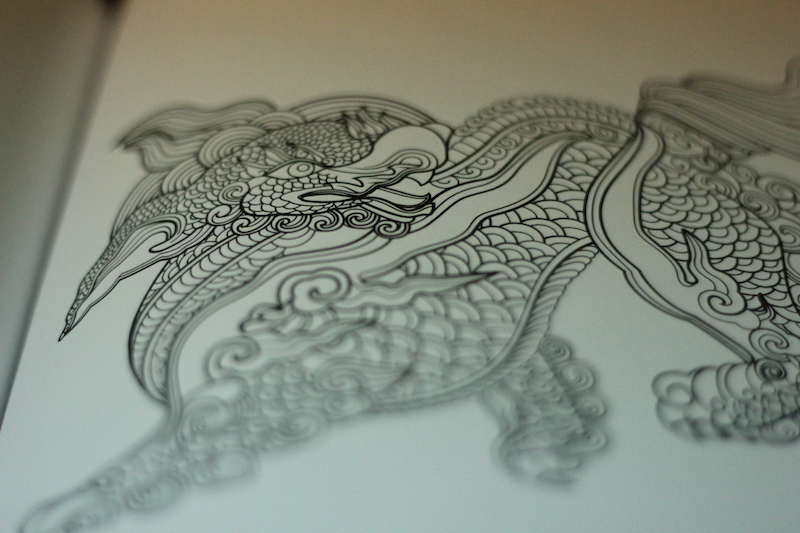Zunk, a central figure in Hanoi’s street art scene, discusses hip-hop, supporting the community and the future of Vietnamese graffiti

I meet Zunk by the corner of the Cuban Embassy. We walk together down a few alleyways, heading to his studio for the next few months. As we walk, something about him immediately strikes me. He has a way about him that few people have. There is a lightness to his being, an ease in the way in which he talks about his life and his work. It’s something I’ve come across only a few times, and almost always occurs when someone has found their calling at a young age and has therefore never been expected to make personal compromises to achieve someone else’s ambition. Zunk, I feel, has been able to follow his own path from very early on. The result is this lightness; there’s no bitterness to speak of, no complaints, no furrow in the brow.
We head up a dusty old wooden staircase and into his studio, a compact room with just a few chairs, books and a laptop open on his desk. Graffiti art covers the walls, including canvases for sale, and a large, somewhat imposing impression of Bart Simpson. One of the books on his desk is a copy of Dunkare, the hiphop magazine he’s recently edited and published. I wonder if it was hip-hop or street art that first drew him in?
“I got involved in street art first, in 2006,” he says, with a slow grin, “but both scenes started at the same time, in early 2000. And then, in 2010, which was 1,000 years of Hanoi, the government became strict. They wanted to keep everything clean, so we had to stop painting on the streets for a few years. Later on, when foreigners from the UK came to live in Hanoi, they started painting things like flowers or about the environment. They painted things that were easier for people to understand. They brought up the spirit of street art in Hanoi.”

He goes on to mention some of the best street artists in the city, including Mate (pron. Ma Tay), who happens to be from Bristol. Considering the artistic heritage of this particular British city (the home of Banksy, among many others), it’s curious to hear how Mate became ingrained in the scene here. “It’s special because he started painting in Vietnam, not in the UK. He’s only been painting for five years, but he’s the one who has the most paintings on the street. He’s not only good at tagging but also painting portraits as well.”
Graffiti is considered one of the four hip-hop elements, and it’s clear the mediums are intertwined in Hanoi. To Zunk, the hip-hop scene is ‘bigger’ than street art; “Hip-hop includes graffiti, and also break-dance and rap,” he says as he lights a cigarette. “With graffiti you learn when you paint. There aren’t as many opportunities. With breakdance or rap you just take your time and train with your friends. With graffiti you have to invest more money. You can dance without money.”
Supporting the Community
That said, it was Banksy himself who said that “graffiti is one of the few tools you have if you have almost nothing.” And as with other outsider art forms—hip-hop, parkour, skateboarding—street art offers a chance to get involved in something not only creative but subversive, and a community in which introverted artists can feel a sense of belonging. On the surface, Vietnam seems an ideal place for it. In a country where generational differences are so pronounced, many young people are trying to find new ways to express themselves. And besides, Khoan Cat Be Tong stencils have already covered Hanoi’s streets for years. Bare concrete walls dominate cityscapes, a myriad of canvases waiting to be painted. But it also depends on the society that supports it. Graffiti only really exists here in Hanoi and Saigon, and even in those cities, it took time for the scene to develop and take hold. Zunk freely admits that their work then was “not very good,” which didn’t help the public perception of street art in Hanoi.

Hunter S. Thompson memorably said that graffiti is beautiful in the way that ‘a brick in the face of a cop’ is beautiful. In Vietnam, it doesn’t always seem to be the edgy subculture it is elsewhere. There are aspects of it that are, with illegal tagging becoming more commonplace, but at the same time, much of the art is actually designed to support the community. Some of Zunk’s latest work, for example, is on the wall of an orphanage in Ba Vi. A lot of the paid work available is for businesses—restaurants or coffee shops—who want their establishments to be more appealing to Vietnamese youth or foreigners. The intention is to create “meaningful” art that has a “good impact” on the community.
He points to a book on the table. It’s a collection of art collected from temples and other religious sites around Vietnam and East Asia. “I’m interested in traditional art,” he says, as cigarette smoke coils over his flat peak cap. “I like to paint traditional styles, but with graffiti. I use the detail from traditional art and make it modern. Because you have to find a new thing. That’s why the title of my magazine is ‘the art of being unique.’ If you copy somebody, you will never have the respect of the community—you’ll be dissed by everyone.”

The scene, he says, is improving and becoming more communicative thanks to the internet, which is “like a dictionary for people who want to know about hiphop and street art.” Online forums have connected artists, and they also travel to other cities now and share knowledge. “In 2012, we were sponsored by a tourist group in Ha Long Bay. They organized the painting of a 160-meter wall, which became the longest graffiti wall in Vietnam. That’s the only opportunity graffiti writers from the north and south have had to work together. There were 21 artists from Hanoi and another 21 from Saigon.”
“I think street art is developing quite quickly. Nowadays, the number of artists is going up. But they bomb so much I’m worried about the communities’ reaction to so much bombing. In Hanoi, the bombing is developing also, but not as quickly as in Saigon because in Hanoi there are police going around every night. But we have more permission walls now where we can paint and make art work without any confusion.”
For the uninitiated, ‘bombing’ is when an artist heads out and quickly paints numerous areas or walls. This might include painting tags, which is a kind of stylized signature. Tags are the simplest and most prevalent type of graffiti. It’s the entry point for many artists, but there are, of course, many other skills that follow, which Zunk and other artists are learning as they go. “We didn’t know about stencilling in the beginning. We used to think using a brush is not street art—you should use a can. But that’s changed now.”
It’s not the only thing in flux. He adds that many artists are now trying to find a way to adapt graffiti into “real life,” with many becoming tattoo artists or being commissioned to paint spaces. Around the world, many graffiti purists might protest at the idea of working with businesses. The phrase ‘selling out’ comes to mind. But, then again, this isn’t the rest of the world.

Later on I catch up with Zunk at an exhibition he’s working on, at the Vincom Center for Contemporary Art in Royal City. He’s creating graffiti art on the gallery walls, clearly inspired by the kind of traditional fine art he showed me in his studio. Each weekend, a number of graffiti artists live in the space, so visitors can see the process and not just the finished piece. It sounds like a logical progression, a stepping stone from unbridled passion to actually making a living. One would hope it’s also a way of working that’s relatively free of compromise. And if this is the case, Zunk’s lightness and carefree manner, that quality I so admire, will remain undimmed.
Text and Images by Chris Humphrey


